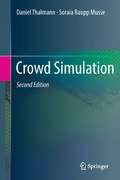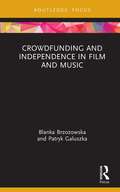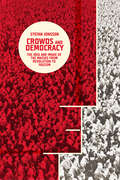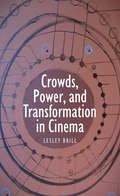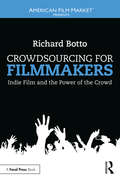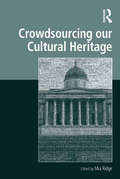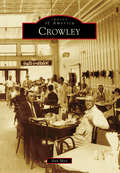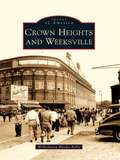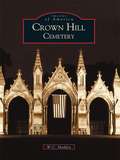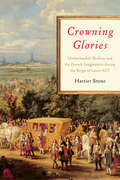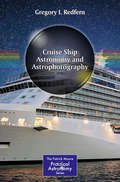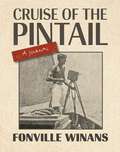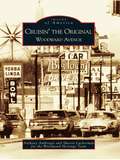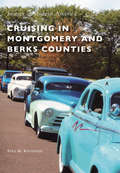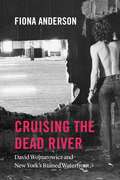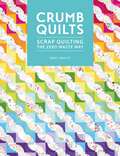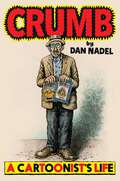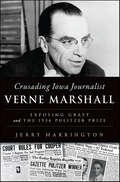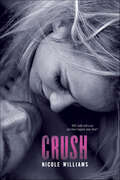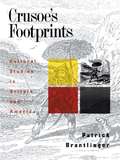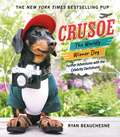- Table View
- List View
Crossroads of Culture: Anthropology Collections at the Denver Museum of Nature & Science
by Stephen E. Nash Steven R. Holen Chip ColwellThe hectic front of the Denver Museum of Nature & Science hides an unseen back of the museum that is also bustling. Less than 1 percent of the museum's collections are on display at any given time, and the Department of Anthropology alone cares for more than 50,000 objects from every corner of the globe not normally available to the public. This lavishly illustrated book presents and celebrates the Denver Museum of Nature & Science's exceptional anthropology collections for the first time. The book presents 123 full-color images to highlight the museum's cultural treasures. Selected for their individual beauty, historic value, and cultural meaning, these objects connect different places, times, and people. From the mammoth hunters of the Plains to the first American pioneer settlers to the flourishing Hispanic and Asian diasporas in downtown Denver, the Rocky Mountain region has been home to a breathtaking array of cultures. Many objects tell this story of the Rocky Mountains' fascinating and complex past, whereas others serve to bring enigmatic corners of the globe to modern-day Denver. Crossroads of Culture serves as a behind-the-scenes tour of the museum's anthropology collections. All the royalties from this publication will benefit the collections of the Denver Museum of Nature & Science's Department of Anthropology.
Crowd Simulation
by Daniel Thalmann Soraia Raupp MusseResearch into the methods and techniques used in simulating crowds has developed extensively within the last few years, particularly in the areas of video games and film. Despite recent impressive results when simulating and rendering thousands of individuals, many challenges still exist in this area. The comparison of simulation with reality, the realistic appearance of virtual humans and their behavior, group structure and their motion, and collision avoidance are just some examples of these challenges. For most of the applications of crowds, it is now a requirement to have real-time simulations - which is an additional challenge, particularly when crowds are very large. Crowd Simulation analyses these challenges in depth and suggests many possible solutions. Daniel Thalmann and Soraia Musse share their experiences and expertise in the application of: · Population modeling · Virtual human animation · Behavioral models for crowds · The connection between virtual and real crowds · Path planning and navigation · Visual attention models · Geometric and populated semantic environments · Crowd rendering The second edition presents techniques and methods developed since the authors first covered the simulation of crowds in 2007. Crowd Simulation includes in-depth discussions on the techniques of path planning, including a new hybrid approach between navigation graphs and potential-based methods. The importance of gaze attention - individuals appearing conscious of their environment and of others - is introduced, and a free-of-collision method for crowds is also discussed.
Crowdfunding and Independence in Film and Music (Routledge Focus on Media and Cultural Studies)
by Patryk Galuszka Blanka BrzozowskaThis book explores how independent film and music artists and labels use crowdfunding and where this use places crowdfunding in the contemporary system of cultural production. It complements an analysis of independence in film and music with the topic of crowdfunding as a firmly established form of financing cultural activity. In the second half of the 20th century, the concept of artistic independence was vital to classifying and distinguishing artists, their works, and labels or publishers who released them. However, during the last three decades, this term has become increasingly blurred, and some commentators argue that independence is in crisis. Can crowdfunding be the answer to this crisis? Some believe that it is, whereas others argue otherwise, seeing crowdfunding instead as just the next manifestation of this crisis. This dilemma is a starting point for the analyses of the relationships between crowdfunding and artistic independence conducted in this book, and will be of great interest to people looking for a deeper understanding of crowdfunding, how it can influence artistic independence, and what it means for artists and audiences. It will be a stimulating read for scholars and students with an interest in media and cultural studies, digital humanities, fandom, sociology, economics, business studies, and law, while also offering insights to artists and practitioners in the creative industries.
Crowds and Democracy
by Stefan JonssonBetween 1913 and 1933, the masses became a decisive preoccupation of European culture, fueling modernist movements in art, literature, architecture, theater, and cinema, as well as the rise of communism, fascism, and experiments in radical democracy. Spanning aesthetics, cultural studies, intellectual history, and political theory, this volume unpacks the significance of the shadow agent known as "the mass" during a critical period in European history. It follows its evolution into the preferred conceptual tool for social scientists, the ideal slogan for politicians, and the chosen image for artists and writers trying to capture a society in flux and a people in upheaval. This volume is the second installment in Stefan Jonsson's epic study of the crowd and the mass in modern Europe, building on his work in A Brief History of the Masses, which focused on monumental artworks produced in 1789, 1889, and 1989.
Crowds and Democracy: The Idea and Image of the Masses from Revolution to Fascism (Columbia Themes in Philosophy, Social Criticism, and the Arts)
by Stefan JonssonBetween 1918 and 1933, the masses became a decisive preoccupation of European culture, fueling modernist movements in art, literature, architecture, theater, and cinema, as well as the rise of communism and fascism and experiments in radical democracy. Spanning aesthetics, cultural studies, intellectual history, and political theory, this volume unpacks the significance of the shadow agent known as "the mass" during a critical period in European history. It follows its evolution into the preferred conceptual tool for social scientists, the ideal slogan for politicians, and the chosen image for artists and writers trying to capture a society in flux and a people in upheaval. This volume is the second installment in Stefan Jonsson's epic study of the crowd and the mass in modern Europe, building on his work in A Brief History of the Masses, which focused on monumental artworks produced in 1789, 1889, and 1989.
Crowds, Power, and Transformation in Cinema
by Lesley BrillA noted critic brings crowd theory to Film Studies, offering a bold new analysis of the pervasive cinematic themes of transformation and power.
Crowdsourcing for Filmmakers: Indie Film and the Power of the Crowd (American Film Market Presents)
by Richard BottoWhether you’re a producer, screenwriter, filmmaker, or other creative, you probably have a project that needs constant exposure, or a product to promote. But how do you rise above the noise? In Crowdsourcing for Filmmakers: Indie Film and the Power of the Crowd, Richard Botto explains how to put crowdsourcing to use for your creative project, using social media, networking, branding, crowdfunding, and an understanding of your audience to build effective crowdsourcing campaigns, sourcing everything from film equipment to shooting locations. Botto covers all aspects of crowdsourcing: how to create the message of your brand, project, or initiative; how to mold, shape, and adjust it based on mass response; how to broadcast a message to a targeted group and engage those with similar likes, beliefs, or interests; and finally, how to cultivate those relationships to the point where the message is no longer put forth solely by you, but carried and broadcasted by those who have responded to it. Using a wealth of case studies and practical know-how based on his years of experience in the industry and as founder of Stage 32—the largest crowdsourced platform for film creatives—Richard Botto presents a comprehensive and hands-on guide to crowdsourcing creatively and expertly putting your audience to work on your behalf.
Crowdsourcing our Cultural Heritage (Digital Research in the Arts and Humanities)
by Mia RidgeCrowdsourcing, or asking the general public to help contribute to shared goals, is increasingly popular in memory institutions as a tool for digitising or computing vast amounts of data. This book brings together for the first time the collected wisdom of international leaders in the theory and practice of crowdsourcing in cultural heritage. It features eight accessible case studies of groundbreaking projects from leading cultural heritage and academic institutions, and four thought-provoking essays that reflect on the wider implications of this engagement for participants and on the institutions themselves. Crowdsourcing in cultural heritage is more than a framework for creating content: as a form of mutually beneficial engagement with the collections and research of museums, libraries, archives and academia, it benefits both audiences and institutions. However, successful crowdsourcing projects reflect a commitment to developing effective interface and technical designs. This book will help practitioners who wish to create their own crowdsourcing projects understand how other institutions devised the right combination of source material and the tasks for their ’crowd’. The authors provide theoretically informed, actionable insights on crowdsourcing in cultural heritage, outlining the context in which their projects were created, the challenges and opportunities that informed decisions during implementation, and reflecting on the results. This book will be essential reading for information and cultural management professionals, students and researchers in universities, corporate, public or academic libraries, museums and archives.
Crowley
by Ann MireHow do you build a town from scratch? The first ingredient is a dream. W.W. Duson served as the chef with a vision for a new town. With the railroad completed through southwestern Louisiana in 1881, Duson, general manager of the Southwestern Louisiana Land Company, orchestrated the purchase of land along the railroad. Railroader Patrick Crowley moved his "Crowley Switch" house depot to the new townsite as Duson stirred interest through advertisements in Midwestern newspapers. Duson blended the surveying, bringing 100 workers to clear the land, with Duson Brothers' real estate business to help shape the town. Mixed in were special excursion trains that brought in prospective buyers of lots and farmland. Finally, a heaping helping of pioneer adventurers--including merchant Jac Frankel, physician D.P. January, farmer brothers C.J. and Thomas Freeland, attorney James Barry, banker Preston Lovell, and many others--were added to spice up the town.
Crown Heights and Weeksville (Images of America)
by Wilhelmena Rhodes KellyThe communities of Crown Heights and Weeksville are historically significant Brooklyn neighborhoods with foundations that trace back to New York's early founding. Revolutionary War skirmishes took place there, and following the emancipation of slaves in 1827, Weeksville became the site of one of New York's earliest independent African American townships. The hills of Brooklyn's Green Mountains hindered early settlement, and as a result a plethora of community institutions instead abounded in this far-flung outpost, including a penitentiary, hospitals, almshouses, old-age homes, convents, and monasteries. Traces of some of these early structures still remain. Using vintage images, Crown Heights and Weeksville chronicles the dynamic evolution of this area from rural township to the desirable center of culture, urban convenience, and architectural beauty.
Crown Hill Cemetery
by W. C. MaddenIndianapolis' Crown Hill Cemetery is noted for its unique beauty and historic significance. Dedicated on June 1, 1864, the cemetery, at more than 555 acres, is the final resting-place to over 185,000 citizens and is one of the most historically significant areas in the city. Many of the country's great leaders, soldiers, entrepreneurs, and artists are buried within the cemetery's confines including: President Benjamin Harrison, Col. Eli Lilly, and the infamous John Dillinger, to name just a few. Within these pages of vintage photographs, the history and beauty of Crown Hill Cemetery is revealed. Author W.C. Madden examines such structures as the inspiring Waiting Station and Gothic Chapel, both of which were built in the 1800s. He also details the ground's viscerahl history exemplified by the National Cemetery, dedicated to those who served our country, and the Confederate lot on the cemetery's south grounds.
Crowning Glories: Netherlandish Realism and the French Imagination during the Reign of Louis XIV
by Harriet StoneCrowning Glories integrates Louis XIV’s propaganda campaigns, the transmission of Northern art into France, and the rise of empiricism in the eighteenth century – three historical touchstones – to examine what it would have meant for France’s elite to experience the arts in France simultaneously with Netherlandish realist painting. In an expansive study of cultural life under the Sun King, Harriet Stone considers the monarchy’s elaborate palace decors, the court’s official records, and the classical theatre alongside Northern images of daily life in private homes, urban markets, and country fields. Stone argues that Netherlandish art assumes an unobtrusive yet, for the history of ideas, surprisingly dramatic role within the flourishing of the arts, both visual and textual, in France during Louis XIV’s reign. Netherlandish realist art represented thinking about knowledge that challenged the monarchy’s hold on the French imagination, and its efforts to impose the king’s portrait as an ideal and proof of his authority. As objects appreciated for their aesthetic and market value, Northern realist paintings assumed an uncontroversial place in French royal and elite collections. Flemish and Dutch still lifes, genre paintings, and cityscapes, however, were not merely accoutrements of power, acquisitions made by those with influence and money. Crowning Glories reveals how the empirical orientation of Netherlandish realism exposed French court society to a radically different mode of thought, one that would gain full expression in the Encyclopédie of Diderot and d’Alembert.
Cruise Ship Astronomy and Astrophotography (The\patrick Moore Practical Astronomy Ser.)
by Gregory I. RedfernEnrich your next sea vacation with this fun how-to guide to observing and doing astrophotography on water. Collecting together the author’s five decades of astrophotography and teaching experience, this book shares all the practical information you will need to start on your own astronomy adventure.Part I is full of practical advice on what to pack, the best ways to enjoy the night sky from your cruise ship observatory, specific astronomical objects and events to look out for, and myriad other useful tips. Part II gives you a crash course on astrophotography at sea, teaching you the nitty-gritty details of taking pictures of the night sky. Proof that it can be done is provided by the many amazing color astrophotographs taken by the author while following the steps laid out in this book.
Cruise of the Pintail: A Journal (The Hill Collection: Holdings of the LSU Libraries)
by Robert L. Winans James R. TurnerIn 1932 a young Fonville Winans (1911--1992) left his home in Fort Worth and set out on the waterways of south Louisiana searching for adventure and fortune. This journal recounts, in his own words, how the now-renowned photographer and his two friends -- first mate Bob Owen and second mate Don Horridge -- ventured onto untamed Louisiana waters aboard a leaking, rudderless sailboat, the Pintail. Fonville was shooting footage for a movie that he felt certain would make them rich and famous, telling the story of subtropical south Louisiana's remote coastal landscapes and its curious people. The project was ambitious and risky -- just the right combination for three young Texans with hopes of stardom. Developing his photographic skill, Fonville traveled during the summers of 1932 and 1934 to swamps, barrier islands, and reefs, from Grand Isle to New Orleans to the Atchafalaya, making friends and taking pictures. The journal, in effect, layers Fonville's unique voice over his now-iconic visual record of moving images and stills. Robert L. Winans selected more than one hundred photos to accompany his father's diary entries, offering a fascinating inner look at Fonville Winans's world.
Cruisin' the Original Woodward Avenue (Images of America)
by Anthony Ambrogio Woodward Heritage Team Sharon LuckermanIn the 1950s, cruising swept the nation. American street became impromptu racetracks as soon as the police turned their backs. Young people piled into friends' cars and cruised their main streets with a new sense of freedom. Pent-up desires after the hardships of World War II plus a booming economy fueled a car-buying frenzy. To lure buyers to their particular makes and models, automobile companies targeted the youth market by focusing on design and performance. No place was that more relevant than on metro Detroit's Woodward Avenue, the city's number-one cruising destination and home of the world's automobile industry. Barely 50 years earlier, Henry Ford rolled his first Model T off the assembly line at Piquette and Woodward, just south of where cruisers, dragsters, and automobile engineers ignited each other's excitement over cars. This unique relationship extended into the muscle car era of the 1960s, as Woodward Avenue continued to reflect the triumphs and downturns of the industry that made Detroit known throughout the world.
Cruising in Montgomery and Berks Counties (Images of Modern America)
by Tina M. KissingerMontgomery and Berks Counties have been central to the car industry for decades, employing residents of the cities and surrounding small towns. Pottstown first came to be known as the cruising capital of the East Coast in the 1950s and held on to the title for many years. In the 1960s, hundreds would line the sidewalks to watch the hot rods and classic cars cruise down High Street. Among the circuit favorites were the Tropical Treat, Hilltop Drive-In, and Dempsey Diner. Lansdale also attracted automobile enthusiasts who enjoyed "cruising the Dale." In 1962, the Maple Grove Raceway, a quarter-mile strip in Mohnton, opened and became home to the popular Super Chevy Weekend, hosting great drivers like Fred Spezio, Ken Hall, and John Johnson. The Grandview Speedway and the Reading Fairgrounds Speedway also emerged, attracting even more auto racing enthusiasts from around the area. Today, longtime residents enjoy reminiscing their beloved cruising pastime, with many belonging to historical automotive clubs.
Cruising the Dead River: David Wojnarowicz and New York's Ruined Waterfront
by Fiona AndersonIn the 1970s, Manhattan’s west side waterfront was a forgotten zone of abandoned warehouses and piers. Though many saw only blight, the derelict neighborhood was alive with queer people forging new intimacies through cruising. Alongside the piers’ sexual and social worlds, artists produced work attesting to the radical transformations taking place in New York. Artist and writer David Wojnarowicz was right in the heart of it, documenting his experiences in journal entries, poems, photographs, films, and large-scale, site-specific projects. In Cruising the Dead River, Fiona Anderson draws on Wojnarowicz’s work to explore the key role the abandoned landscape played in this explosion of queer culture. Anderson examines how the riverfront’s ruined buildings assumed a powerful erotic role and gave the area a distinct identity. By telling the story of the piers as gentrification swept New York and before the AIDS crisis, Anderson unearths the buried histories of violence, regeneration, and LGBTQ activism that developed in and around the cruising scene.
Cruisy, Sleepy, Melancholy: Sexual Disorientation in the Films of Tsai Ming-liang
by Nicholas de VilliersA brilliant approach to the queerness of one of Taiwan&’s greatest auteurs A critical figure in queer Sinophone cinema—and the first director ever commissioned to create a film for the permanent collection of the Louvre—Tsai Ming-liang is a major force in Taiwan cinema and global moving image art. Cruisy, Sleepy, Melancholy offers a fascinating, systematic method for analyzing the queerness of Tsai&’s films.Nicholas de Villiers argues that Tsai expands and revises the notion of queerness by engaging with the sexuality of characters who are migrants, tourists, diasporic, or otherwise displaced. Through their lack of fixed identities, these characters offer a clear challenge to the binary division between heterosexuality and homosexuality, as well as the Orientalist binary division of Asia versus the West. Ultimately, de Villiers explores how Tsai&’s films help us understand queerness in terms of spatial, temporal, and sexual disorientation.Conceiving of Tsai&’s cinema as an intertextual network, Cruisy, Sleepy, Melancholy makes an important addition to scholarly work on Tsai in English. It draws on extensive interviews with the director, while also offering a complete reappraisal of Tsai&’s body of work. Contributing to queer film theory and the aesthetics of displacement, Cruisy, Sleepy, Melancholy reveals striking connections between sexuality, space, and cinema.
Crumb Quilts: Scrap Quilting the Zero Waste Way
by Emily BaileyCrumb quilting is the ultimate way to zero waste patchwork using tiny scraps or 'crumbs' of fabric that are so small that most people would throw them away. This collection includes instructions and techniques for how to turn your stash of crumbs into beautiful quilts and quilted projects. Tiny fabric scraps or 'crumbs' don't have to end up in the bin - now you can learn how to use these crumbs to create 15 beautiful quilts and quilted projects to bust your stash. Author, Emily Bailey, explains how to make fabric from 'crumbs' which you can then cut to your preferred size and use as a quilt block, a dramatic background fabric or as a piece of applique for added texture and interest. These instructions include step-by-step photography for extra clarity around the techniques. Emily shows you how to quickly piece together small scraps to create larger pieces of 'crumb fabric' using chain piecing to build up the fabric. All of the instructions are accompanied with step photography so you see exactly how to create your own scrappy fabrics. There are also instructions for all the quilting techniques you will need to sandwich, baste and bind your quilts and projects. As well as the step-by-step instructions and photography for how to make the crumb fabric Emily also shares her tips and tricks for how to group fabric colours and prints in order to get the best results. In addition to the instructions for how to create background crumb fabric, crumb blocks and crumb applique there are also step-by-step instructions for 15 stunning quilted projects including full-size bed quilts and smaller projects including a pillow and pin cushion. Choose from a full-size bed quilt which features crumb piecing in all its different forms: as a background; as applique and in blocks, to spectacular effect. Other quilts include Under The Sea - a crumb quilt featuring a whole host of scrappy sea creatures and Night Sky - a dramatic quilt which uses crumbs to create a richly textured background with crumb applique for the stars and planets. So why not take another look at your own stash of crumbs and get patchwork and quilting the zero waste way!
Crumb: A Cartoonist's Life
by Dan Nadel&“A definitive and ideal biography—pound for pound, one of the sleekest and most judicious I&’ve ever read.&” —Dwight Garner, The New York Times A critical darling, Crumb is the first biography of Robert Crumb—one of the most profound and influential artists of the 20th century—whose frank, and meticulously rendered cartoons and comics inspired generations of readers and cartoonists, from Art Spiegelman to Alison Bechdel.Robert Crumb is often credited with single-handedly transforming the comics medium into a place for adult expression, in the process pioneering the underground comic book industry, and transforming the vernacular language of 20th-century America into an instantly recognizable and popular aesthetic. Now, for the first time, Dan Nadel, delivers a &“gripping and essential account&” (The Boston Globe) of how this complicated artist survived childhood abuse, fame in his twenties, more fame, and came out the other side intact. Braiding biography with &“cultural history and criticism...that honors the complexity of [its] subject, even, perhaps particularly, when it gets ugly&” (Los Angeles Times), Crumb is the story of a richly complex life at the forefront of both the underground and popular cultures of post-war America. Including forty-five stunning black-and-white images throughout and a sixteen-page color insert featuring images both iconic and obscure, Crumb spans the pressures of 1950s suburban America and Crumb&’s highly dysfunctional early family life; the history of comics and graphic satire; 20th-century popular music; the world of the counterculture; the birth of underground comic books in 1960s San Francisco with Crumb&’s Zap Comix; the economic challenges and dissolution of the hippie dream; and the path Robert Crumb blazed through it all. Written with Crumb&’s cooperation, this fascinating, rollicking book takes in seven decades of Crumb&’s iconic works, including Fritz the Cat, Weirdo, and his adaptation of The Book of Genesis and &“floats Crumb on the rapids of his times&” (Harper&’s Magazine), capturing, in the process, the essence of an extraordinary artist.
Crunchyroll Essential Anime: Fan Favorites, Memorable Masterpieces, and Cult Classics
by Patrick Macias Samuel SattinAn insightful guide to the under-explored medium of anime, Crunchyroll's Essential Anime features 50 influential and unforgettable anime series and films that have left an undeniable impact on our culture. More than just a list of anime to watch, Essential Anime digs into the distinct stories of the creators and studios behind the making of these must-see anime titles, as well as the personal connections and importance they hold with anime fans around the world. With commentary on anime's history and lasting appeal, recommendation lists, and hundreds of stunning images, Crunchyroll's Essential Anime is an indispensable guide for anime lovers and fans, offering an entertaining and moving narrative about anime's true impact on pop culture.Ranging from classic and modern series and films this official guide will explore iconic and must-see: Feature films: Akira (1988), Princess Mononoke (1997), Millennium Actress (2001), Metropolis (2001), Tekkonkinkreet (2006), Sword of the Stranger (2007), Summer Wars (2009), and Your Name (2016) Series: Astro Boy (1963), Lupin the 3rd (1967), Macross (1982), Ranma 1/2 (1989), Neon Genesis Evangelion (1995), Dragon Ball Z (1989), Sailor Moon (1992), Revolutionary Girl Utena (1997), Pokémon (1997), One Piece (1999), K-On! (2007), Fullmetal Alchemist: Brotherhood (2009), Sword Art Online (2012), Yuri On Ice!!! (2016), My Hero Academia (2018), and Demon Slayer: Kimetsu no Yaiba (2019)And more!
Crusading Iowa Journalist Verne Marshall: Exposing Graft and the 1936 Pulitzer Prize
by Jerry HarringtonOn December 12, 1934, police raided a canning factory in Cedar Rapids, uncovering an illegal liquor and gambling set-up. Verne Marshall, tempestuous editor of the Cedar Rapids Gazette, sensed a bigger story and a wider network of corruption. His aggressive investigative reporting led to multiple resignations, nearly fifty indictments and the dramatic trial of the state's attorney general. These explosive exposés earned Verne Marshall and the paper the 1936 Pulitzer Prize. Author Jerry Harrington traces the legacy of Marshall's incendiary crusade across Iowa's political landscape.
Crush: Includes Crash, Clash And Crush (Crash #3)
by Nicole WilliamsThe conclusion to the New York Times bestselling Crash trilogy, never before published in any format!A football fantasy. A giant diamond. The modern-day Romeo and Juliet are taking their relationship to the next level. . . . Jude and Lucy are happily engaged, but that doesn't mean life's a bed of roses.Once again, the hottest couple around is torn apart, this time by football training and a summer job. Now it's Jude with the trust issues.Will Lucy's life-changing news bring them back together or end their relationship for good? Can love triumph forever?Find out in the best installment yet in Nicole Williams's racy and romantic Crash trilogy!
Crusoe's Footprints: Cultural Studies in Britain and America
by Patrick Brantlinger"Cultural Studies" has emerged in British and American higher education as a movement that challenges the traditional humanities and social science disciplines. Influenced by the New Left, feminism, and poststructualist literary theory, cultural studies seeks to analyze everday life and the social construction of "subjectivities." Crusoe's Footprints encompasses the movement of many colleges and universities in the 1960s towards such interdisciplinary and "radical" programs as American Studies, Women's Studies, and Afro-American Studies. Brantlinger also examines the role of feminist criticism which has been particularly crucial in both Britain and the U.S.
Crusoe, the Worldly Wiener Dog: Further Adventures with the Celebrity Dachshund
by Ryan BeauchesneThe New York Times bestselling, popular blogger, internet sensation Crusoe, the Celebrity Dachshund returns with a beautiful and whimsical book full of heartwarming and goofy photographs of his around the world travels in Crusoe, the Worldly Wiener Dog.Join the photogenic Crusoe as he leaves fame and fortune behind to expand his horizons, get his passport stamped, and journey across the globe to eat delicious food, relax on beautiful beaches, dig lots of holes, and generally enjoy all that celebrity travel has to offer. You'll also get to see a little of his "staycations" and life at home between travels.Jet-setting is what dachshunds do best. From Switzerland’s Alps and Mexico’s Mayan temples to Italy’s seaside villages and France’s Eiffel Tower—as well as various locales throughout the U.S. and Canada—Crusoe shares his wit and wisdom on appreciating culture, fine wine, and haute cuisine, always dressing for the occasion, and maybe learning a thing or two about what really matters most in life along the way.In hundreds of brilliant color photographs, see the charming and charismatic mini-doxie embark on such thrilling adventures as…* Hitting the streets of New York City as The Wiener of Wall Street* Stalking evildoers as Batdog * Strolling Hollywood’s Walk of Fame (with his own star)* Going out on a dinner and movie date with the lovely Paisley* Digging for fossils at Dinosaur Provincial Park* Playing doctor and dentist to his sidekick brother, Oakley* Drinking at the notorious Bar Vitelli, shooting location of The Godfather* Recovering from back surgery with lots of love and rehabilitating in style * Tasting a beignet at New Orleans’s famous Café du Monde* Exploring his German heritage as a “badger dog”—and discovering what wiener schnitzel actually is…And so much more!

